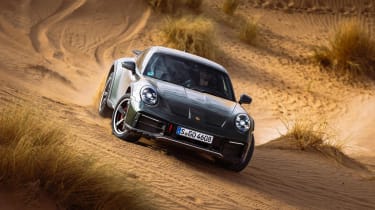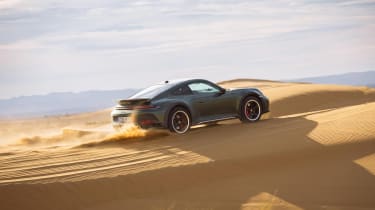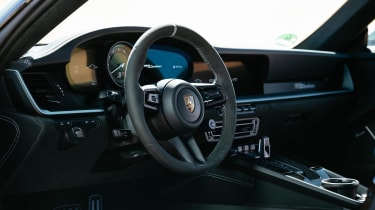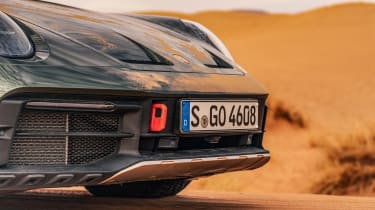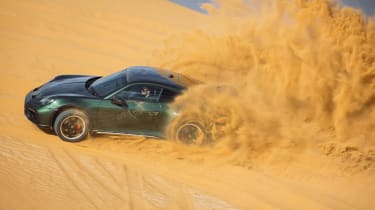Porsche 911 Dakar 2023 review
A broadly pointless example of Porsche making just about any 911 drive incredibly well
The sheer depth of the Porsche 911 line-up has become pretty breath-taking of late. Yet at a stroke Porsche has seemingly managed to broaden its appeal further still by introducing the go-anywhere, do-anything Dakar.
What we are talking about here is a 911 that’s based heavily on a regular GTS (same engine, gearbox, four-wheel steering and four wheel-drive systems, same brakes and fundamental suspension design) that also happens to match a Cayenne off-road.
So what do you get for your £173,000, and how does the Dakar differ from the GTS on which it’s based? It rides some 50mm higher than a GTS and can be raised electronically by a further 30mm for maximum ground clearance with arrival and departure angles the same as a Cayenne’s.
Although its suspension is fundamentally unchanged from a GTS’s with struts at the front and a five-link axle at the back, the springs are longer and have been softened considerably while the dampers are also beefier (and are still adjustable via the PASM system but with additional Rallye and Off Road modes in place of Sport+) that feature “Dakar-specific tuning.”
Underneath is a series of CFD panels that protect its innards from unwanted intrusions. The sills are also made of metal to increase their thump-ability while the glass is thicker and stronger for the same reason.
More reviews
In-depth reviews
Reviews
> Porsche 911 Sport Classic (992) review
To offset this weight gain, the bonnet is made from carbon composite and appears to weigh less than air while the rear seats have been ditched to keep the weight down. You can also specify £2091 of roll cage package, and if you want the 1984 commemorative Paris-Dakar ‘Roughroad’ decals that’s another 18-odd grand. Thus far, over 70 per cent of Dakar’s have been specified thus.
Despite this, Porsche has managed to keep the weight down to 1605kg DIN, which makes the Dakar just 10kg heavier than a GTS. Impressive given how much more robust it is – and indeed feels – on the move.
As standard it rides on a bespoke set of bespoke Pirelli All-Terrain tyres – 245/45 19s at the front, 295/40 20s at the rear. Summer, winter and all-season tyres have also been homologated, but considering the Dakar has lapped the Nürburging in 7min 56sec on All-Terrain rubber – with a top speed limited to 149mph/240kmh – you can’t help wonder if summer tyres are even necessary.
Climb inside and it all feels instantly familiar. Same dials, same instruments, same big central touchscreen that you get in a 992 Carrera. The seats are full-blown buckets like the kind you get in a GT3, with the same fixed backrests. With no rear seats when you get going the cabin has that same soundscape as Porsche’s 911 GT models in which stones and road detritus generate more noise than the motor to begin with as they ping into the rear wheel arches.
On a tarmac road the Dakar feels decently refined, and properly quick. The 3.0-litre twin-turbo flat six and eight-speed PDK gearbox deliver the same level of performance as a GTS – with 473bhp and 420lb ft sending it to 62mph in a claimed 3.4sec and to 100mph in 7.8sec.
It also has an unusually smooth ride yet on the move also has more aural character than a GTS due to its decreased sound insulation. It’s just louder basically and sounds more old-school 911, which is great. Plus the reduction in outright grip from the All-Terrain tyres and the extra noise they generate adds to the effect somehow.
Limiting the top speed to 149mph has nothing to do with the gearing, it’s exactly the same as in the GTS, rather Porsche had to knock it back because with its softer springs and increased ride height the Dakar has very different roll and yaw characteristics at high speed, so 149mph it had to be.
Turning left at the end of the runway at Errachidia airport in Morocco, then heading straight into the desert the Dakar blew me away completely with what it could do. How robust it felt. How capable it was. And when some enormous sand dunes appeared in the windscreen for a while it also entertained. It was, whisper this, bloody hilarious to be honest.
Bottom line; although the Dakar will be met with ridicule by some (us included to begin with) there’s no getting away from the fact that, judged in isolation and ignoring the hype, it’s just a really cool car.
